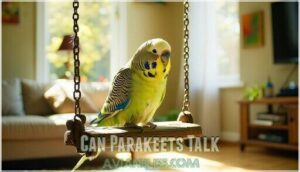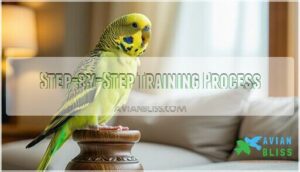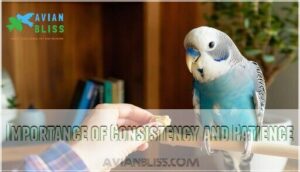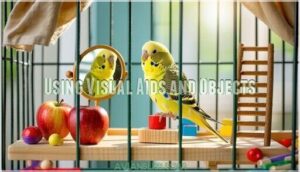This site is supported by our readers. We may earn a commission, at no cost to you, if you purchase through links.

Your parakeet’s syrinx—think of it as their voice box—lets them reproduce sounds they hear repeatedly. With patience and consistent training, many parakeets learn dozens or even hundreds of words.
Male parakeets typically pick up speech faster than females, and younger birds are often quicker learners. Start with simple words like "hello" or their name, repeat them daily, and use positive reinforcement when they attempt to mimic you.
The key is creating a bond and making learning fun rather than stressful. Some parakeets become absolute chatterboxes while others prefer their natural chirping—both are perfectly normal. Understanding the specific techniques that release your bird’s vocal potential makes all the difference.
Table Of Contents
- Key Takeaways
- Parakeet Talking Ability
- Can Parakeets Talk
- Parakeet Speech Training
- Factors Influencing Speech
- Training Techniques and Tips
- Advanced Training and Care
- Frequently Asked Questions (FAQs)
- Can parakeets really talk like humans?
- Why do some parakeets talk while others don’t?
- Can all parakeet species talk, or is it only budgerigars?
- Can you teach a parakeet to talk, or is it a natural ability?
- At what age should I start teaching my parakeet to talk?
- How long does it take a parakeet to talk?
- What type of parakeet can talk?
- How long does it take for a parakeet to start talking?
- Can parakeets understand and comprehend the meaning of words?
- Do parakeets recognize their own name when spoken?
- Conclusion
Key Takeaways
- Your parakeet can definitely learn to talk – they use their specialized syrinx organ to mimic human speech, though they will not sound as clear as larger parrots
- Males are better talkers than females – especially young males between 4-6 months old who bond closely with their human companions
- Consistent daily training is key – start with simple words like "hello" or their name, use positive reinforcement with treats, and practice in short 2-minute sessions
- Not every parakeet will become a chatterbox – while 80% can learn basic words, some prefer their natural chirping, and that is perfectly normal
Parakeet Talking Ability
You might wonder if your feathered friend can actually learn to speak human words.
Parakeets possess remarkable vocal abilities through their specialized syrinx organ, which allows them to mimic and reproduce sounds from their environment, including human speech.
Parakeet Communication Methods
Your parakeet’s communication toolkit includes several distinct vocalizations, each serving specific purposes in their social world.
Understanding these parakeet language skills helps you decode their emotional expression and build stronger bonds.
Here are the main types of parakeet communication:
- Chirping – Basic social interaction and territory establishment
- Whistling – Contentment and musical engagement with their environment
- Squawking – Alarm calls or attention-seeking behavior
- Chattering – Excitement or mild disturbance responses
- Clicking – Pure pleasure and relaxation signals
These sound variety patterns form the foundation of parakeet vocalization, with each serving distinct vocalization purposes in their daily interactions.
Role of Syrinx in Vocalization
Your parakeet’s incredible vocal range stems from its syrinx, a specialized organ that works differently than human vocal cords.
The syrinx gives parakeets their amazing ability to mimic human speech with precision.
This unique bird anatomy enables complex sound production and mimicry mechanisms that vary across species.
| Syrinx Feature | Function | Impact on Vocalization |
|---|---|---|
| Dual sound sources | Independent control of each side | Produces two sounds simultaneously |
| Muscle coordination | Adjusts tension and pitch | Enables precise mimicry mechanism |
| Membrane vibration | Creates sound waves | Generates diverse vocal range |
The syrinx’s location at the trachea base gives parakeets superior parakeet talking ability compared to mammals with single-source larynxes.
Interpretation of Sound Reproduction
When your parakeet mimics sounds, it’s not just copying—it’s trying to communicate with you.
Understanding this intentional communication helps you recognize what your bird is actually saying.
Here’s what your parakeet’s sound mimicry really means:
- Your voice becomes their language – they’re choosing human words over bird calls
- Repetition shows emotional connection – favorite phrases reveal their bond with you
- Context matters – they’ll use specific parakeet words for different situations
This parakeet speech has real meaning, even with mimicry limitations.
Can Parakeets Talk
Why do people wonder if parakeets can actually talk? The answer is yes, but with important caveats. Your parakeet’s speech potential depends on several factors that determine their vocal mimicry success.
Parakeets possess remarkable learning capacity through their syrinx, a specialized vocal organ. However, talking limitations exist based on breed variations and individual differences. Not every parakeet will become a chatterbox, but many can learn basic parakeet words with proper training.
| Talking Factor | High Success | Low Success |
|---|---|---|
| Gender | Male parakeets | Female parakeets |
| Age | 4-6 months old | Over 1 year old |
| Social Setup | Single bird | Multiple birds |
| Human Bonding | Hand-tamed, close bond | Minimal interaction |
Your parakeet’s ability to mimic human speech isn’t guaranteed, but it’s certainly possible. Males typically show stronger parakeet speech development than females, especially when they’re young and socially bonded with their human companions. A sudden silence could indicate underlying health problems needing attention.
Parakeet Speech Training
If you want your parakeet to talk, you’ll need patience, a clear plan, and plenty of practice.
With the right steps and some treats, you can help your bird learn simple words and even short phrases.
Step-by-Step Training Process
Teaching parakeets to talk requires a structured approach that builds on their natural mimicry abilities.
Start with your bird’s name since it’s already familiar, then follow these proven steps:
- Initial Word Choice: Begin with simple words containing clear consonants like "hello," "goodbye," or your parakeet’s name
- Repetition Techniques: Practice the same word 10-15 times during each training session using a clear, distinct voice
- Reward Systems: Offer treats like millet sprays immediately when your bird attempts to mimic the sound
- Session Duration: Keep training sessions short at 2-minute bursts to maintain focus and prevent boredom
- Learning Plateaus: Move to the next word only after your parakeet repeats the current word three times consecutively
This systematic approach to parakeet training builds confidence through positive reinforcement while respecting your bird’s natural learning pace.
Importance of Consistency and Patience
Success in parakeet training depends on establishing daily routine benefits that reinforce learning patterns.
Consistency builds confidence in your bird, while patience prevents avoiding frustration during gradual progress phases.
Teaching parakeets to talk requires steady reinforcement timing – not rushing when your feathered friend stays quiet.
Remember, even chatty humans took years to master conversation! Stick with your parakeet training schedule, celebrating small victories along the way.
Positive reinforcement, including target training methods, can also be very effective.
Using Positive Reinforcement Techniques
Reward timing matters most in parakeet training. Give treats immediately when your bird makes vocal attempts, even imperfect ones.
Millet sprays, celery, and carrots work well for treat variety. Combine vocal praise with physical rewards – say "good job" enthusiastically while offering food.
Clicker training helps mark exact moments of success. Many owners use millet as treats.
Watch for affection signals like head bobbing, showing your positive reinforcement is working effectively.
Associating Words With Objects
Object Familiarization with your parakeet creates powerful Visual Association that boosts Memory Retention.
Hold up items while clearly saying their names – "apple," "ball," or "keys."
This Tactual Learning approach helps parakeets connect words with real things they can see.
Through consistent practice, your bird develops Contextual Understanding, making vocabulary stick better than abstract phrases alone.
Factors Influencing Speech
While all parakeets can make sounds, not every bird will learn to talk like humans do.
Your parakeet’s gender, age, social environment, and bond with you all play vital roles in determining whether it’ll pick up speech or stick to natural chirping.
Gender Differences in Talking Ability
Male parakeets typically excel at talking compared to females.
Their superior male vocalization abilities stem from hormonal influence and enhanced socialization opportunities in nature.
Males learn words faster due to their naturally social behavior, while female parakeets focus more on female territory protection.
When asking "can parakeets talk," gender substantially impacts success rates, with male vs female differences being scientifically documented through learning speed studies.
Social Environment and Exposure
Your parakeet’s social environment acts like a language classroom – the more human interaction and vocal stimulation they receive, the better their mimicry skills develop.
These social creatures thrive on environmental sounds and conversation, making socialization impact essential for parakeet intelligence.
Constant exposure to human voices creates the foundation for successful parakeet behavior training and speech development.
Pet-to-Human Bonding and Trust
Building rapport with your parakeet isn’t just about sweet talk—it’s the foundation for successful training.
Trust opens the door to vocal mimicry, while fear slams it shut.
Here’s how to create that magical connection:
- Spend quality time near the cage without forcing interaction
- Speak gently during daily routines like feeding and cleaning
- Offer treats from your hand to build positive associations
- Respect boundaries when your bird shows signs of stress
Interactive play and creating a secure environment help parakeets feel comfortable enough to attempt talking.
Age and Learning Ability
Age plays a major role in your parakeet’s talking potential. Younger Parakeets between 3-12 months hit the Optimal Age for speech learning, while older birds face a steeper Learning Curve.
Here’s how age affects Cognitive Development:
| Age Range | Learning Ability | Training Duration |
|---|---|---|
| 3-6 months | Excellent | 2-4 weeks |
| 6-12 months | Good | 4-8 weeks |
| 1+ years | Moderate | 8-16 weeks |
| 2+ years | Limited | 16+ weeks |
Bird training works best when you match your approach to your pet’s age and cognitive stage.
Training Techniques and Tips
Now that you understand the key factors that influence your parakeet’s ability to learn speech, you’ll want to focus on creating the right training environment and using proven techniques.
Success depends on combining the right setup with consistent practice and avoiding the common pitfalls that can slow down your bird’s progress, which is crucial for achieving success.
Creating a Conducive Environment
Your parakeet’s environment dramatically impacts their willingness to learn.
Cover three sides of the cage with cloth to minimize distractions and create a focused safe space.
Stand directly in front during training sessions to establish clear social interaction.
Maintain routine consistency with daily 30-minute sessions.
Remove mirrors temporarily to prevent divided attention.
A good option is to think about cage covers for parakeets to further reduce external stimuli.
This controlled setting reduces stress while maximizing your bird’s learning potential through positive reinforcement and proper cage enrichment.
Using Visual Aids and Objects
Something magical happens when you pair words with visual cues during parakeet training. Hold up objects while saying their names—show an apple and repeat "apple" clearly. This Object Association technique helps parakeets connect sounds with meanings.
Arrange your bird’s cage so three sides are covered, creating Visual Focus during training sessions. Remove mirrors temporarily to prevent distractions, though Mirror Usage can comfort single birds otherwise.
Some owners find that training with mirrors can be beneficial. Rotate toys regularly through Toy Rotation to maintain interest and engagement.
Building Trust and Rapport
Trust forms the foundation of successful parakeet training. Your bird won’t learn if it’s constantly stressed or fearful around you.
Start with gentle handling, moving slowly and speaking softly. Watch for body language cues like fluffed feathers or rapid breathing that signal discomfort.
Consistent interaction builds the human-animal bond necessary for effective bird bonding and parakeet behavior modification. Displays of affection such as allopreening demonstrate trust show that your bird feels at ease with you, which is crucial for a strong human-animal bond and successful bird bonding.
Avoiding Common Mistakes and Pitfalls
Don’t rush the parakeet training process or expect overnight results.
Ignoring your bird’s natural vocalizations while overloading vocabulary confuses them.
Insufficient rewards kill motivation, while inconsistent sessions derail progress.
These bird training mistakes sabotage success.
Focus on bird training consistency and patience – your feathered friend needs time to master each word before moving forward.
Advanced Training and Care
Once your parakeet masters basic words, you can expand their vocabulary and tackle more complex behaviors.
This advanced stage focuses on mental enrichment, health maintenance, and understanding your bird’s unique personality quirks, which is crucial for their overall well-being and health maintenance.
Encouraging Vocalization and Chirping
Once your parakeet masters basic words, you can expand their vocal repertoire through strategic environmental enrichment.
Play varied music to encourage mimicry of different sounds and melodies. Interactive toys with recorded voices provide consistent vocal stimulation when you’re away.
Create a mimicking environment by repeating household sounds like doorbells or phone rings.
Use positive reinforcement when your bird attempts new parakeet sounds, rewarding vocal variety with treats and praise during training sessions.
Providing Mental Stimulation and Exercise
Several mental challenges prevent boredom and support parakeet training success.
Toy rotation keeps your bird engaged—swap out puzzle toys weekly to maintain curiosity.
Create foraging opportunities by hiding treats in paper cups or cardboard tubes.
Interactive games like "peek-a-boo" strengthen your bond while providing stimulation.
Daily flight time outside the cage offers essential exercise.
Bird activities should include climbing, chewing, and problem-solving through various bird toys designed for parakeet care.
Maintaining Health and Hygiene
Your parakeet’s health hinges on consistent cage sanitation and water purity.
Clean the cage weekly, replacing water daily to prevent bacterial growth. Wash your hands after handling to avoid salmonella transmission.
Schedule preventative checkups with an avian veterinary professional annually.
Maintain a safe environment by removing hazards and ensuring proper feather care through balanced nutrition and humidity control.
Recognizing and Addressing Behavioral Issues
Behavioral problems often stem from stress, boredom, or health issues.
Watch for these warning signs that indicate your bird needs attention:
- Feather Plucking – indicates stress effects or underlying medical problems requiring immediate intervention
- Aggression Signs – biting prevention starts with recognizing territorial behavior and communication frustrations
- Sleep Disturbances – disrupted rest patterns signal environmental stressors or boredom indicators
Address behavior modification through consistent routines and environmental enrichment.
Unmet needs often trigger common bird behavior.
Frequently Asked Questions (FAQs)
Can parakeets really talk like humans?
Yes, parakeets can mimic human speech.
They don’t understand meaning like we do, but they’re excellent at copying sounds.
You’ll hear them repeat words, phrases, and even household noises with surprising accuracy.
Why do some parakeets talk while others don’t?
Male parakeets talk more than females due to their naturally social nature.
Your bird’s age, bonding with humans, training consistency, and individual personality all influence whether they’ll develop speech skills or remain happily chirpy.
Can all parakeet species talk, or is it only budgerigars?
Back in your grandmother’s parlor days, not every feathered chatterbox could mimic human speech.
Only budgies among parakeet species actually talk.
Other parakeet types don’t possess this remarkable vocal ability that makes budgies such entertaining companions.
Can you teach a parakeet to talk, or is it a natural ability?
You can definitely teach parakeets to talk, it’s a learned skill, not natural.
Males learn easier than females.
Start with simple words, use repetition, and reward progress with treats for best results.
At what age should I start teaching my parakeet to talk?
Like striking while the iron’s hot, you’ll want to start training your parakeet between 4-6 months old when they’re most receptive to learning human speech.
Their minds are keen sponges.
How long does it take a parakeet to talk?
Teaching your parakeet to talk takes patience—most birds need several weeks to months of consistent daily practice before they’ll start mimicking words clearly and confidently.
What type of parakeet can talk?
Male parakeets are the best talkers, especially those 4-6 months old.
Hand-tamed birds in single-bird households learn faster since they bond more closely with humans and aren’t distracted by other parakeets.
How long does it take for a parakeet to start talking?
With patience and consistency, you’ll hear your parakeet’s first words within three to six months.
Young males learn fastest, while some birds need up to a year of daily practice sessions.
Can parakeets understand and comprehend the meaning of words?
Parakeets don’t truly understand word meanings like humans do.
They’re excellent mimics who associate sounds with situations, rewards, or emotions.
Your bird learns patterns and context rather than grasping actual definitions of words, making them excellent at learning through context.
Do parakeets recognize their own name when spoken?
Ever wonder if your feathered friend knows you’re calling them?
Yes, parakeets can recognize their own name when spoken regularly.
They associate the sound with attention, treats, and interaction, making it one of the easiest words they’ll learn to respond to, as they learn to connect the sound with attention.
Conclusion
Research shows that 80% of parakeets can learn basic words with proper training techniques.
So yes, parakeets can talk at all when you create the right environment and use consistent methods.
Your bird’s success depends on daily practice, positive reinforcement, and building trust through patient interaction.
Remember that each parakeet learns differently—some become chatty companions while others prefer their natural chirps.
With dedication and the right approach, you’ll likely discover your feathered friend’s hidden vocal talents waiting to emerge.
- https://www.news-medical.net/news/20250319/Parakeet-brain-reveals-secrets-of-human-like-speech-patterns.aspx
- https://phys.org/news/2025-05-social-networks-vocal-diversity-monk.html
- https://www.reddit.com/r/parrots/comments/18q6cst/budgies_vs_tiels_talking_ability/
- https://www.facebook.com/DavidAllenSibley/posts/-parrots-and-parakeets-are-famous-for-their-ability-to-mimic-human-speech-but-ho/1095519828601519/
- https://www.quora.com/Do-parakeets-have-the-same-ability-to-learn-human-speech-as-cockatiels-and-other-bird-species














